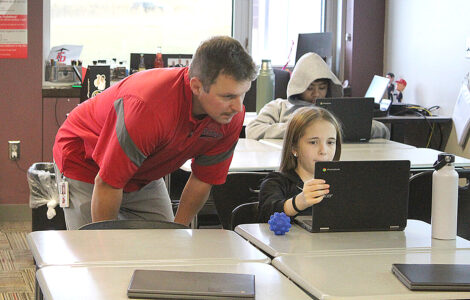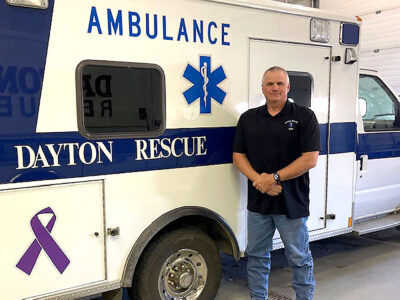‘We need day care’
Governor says child care shortage is one of area’s main workforce challenges
-
-Messenger photo by Hans Madsen
Iowa Gov. Kim Reynolds makes a point during a meeting to discuss child care issues Thursday afternoon at the Fort Dodge Public Library. Lt. Gov. Adam Gregg listens at right.
-
-Messenger photo by Hans Madsen
Elizabeth Stanek, executive director of Linking Families and Communities, speaks Thursday afternoon during a meeting with Gov. Kim Reynolds and Lt. Gov. Adam Gregg at the Fort Dodge Public Library to discuss child care issues.
-
-Messenger photo by Hans Madsen
Dawn Larson, economic development specialist with the city of Fort Dodge, talks about child care issues Thursday afternoon during a meeting with Gov. Kim Reynolds and Lt. Gov. Adam Gregg at the Fort Dodge Public Library.

-Messenger photo by Hans Madsen
Iowa Gov. Kim Reynolds makes a point during a meeting to discuss child care issues Thursday afternoon at the Fort Dodge Public Library. Lt. Gov. Adam Gregg listens at right.
The child care shortage in Fort Dodge and Webster County is directly impacting job recruitment to an area where population has declined for decades, according to information shared during a meeting with Iowa Gov. Kim Reynolds on Thursday. The meeting, held at the Fort Dodge Public Library, was hosted by Linking Families and Commmunities.
“We have had trouble recruiting physicians because they can’t find quality child care for their kids,” said Jessica Smith, supervisor of wellness services and diabetes center at UnityPoint Health — Fort Dodge. “That’s a struggle for us.”
Darci Nemmers, senior administrative assistant for Cargill, revealed that Cargill faces similar challenges with recruitment and retention.
“We are open 24 hours, seven days a week,” Nemmers said. “Our technicians run on a 12-hour shift. Some of the issues they run into is lack of providers and providers that will run limited hours. That’s kind of a problem with them as well. We do have a lot of young engineers that move in with their families. I know when they were looking for places to live, a big thing was, ‘where can I find day care providers?’ Are they going to end up in Webster City, Manson or Humboldt because they can find day care providers there?”
Reynolds acknowledged that day care is interwoven with workforce challenges.

-Messenger photo by Hans Madsen
Elizabeth Stanek, executive director of Linking Families and Communities, speaks Thursday afternoon during a meeting with Gov. Kim Reynolds and Lt. Gov. Adam Gregg at the Fort Dodge Public Library to discuss child care issues.
“We need to skill up, we need housing and we need day care,” Reynolds said. “It’s part of the workforce issue. It’s just not bringing people in. You can’t bring people in if they don’t have day care or a house to live in. It’s all of that. We have to think about it holistically and how we can best utilize our resources.”
The issue of quality child care is something Elizabeth Stanek, executive director of Linking Families and Communities, has been trying to solve for several years.
According to Stanek, Fort Dodge has a shortage of 1,638 child care spaces.
Multiple factors have contributed to that shortfall.
A study completed in July 2019 showed that in Webster County, 76% of families with children under the age of 6 have all parents working. That number is 86% for Fort Dodge specifically.

-Messenger photo by Hans Madsen
Dawn Larson, economic development specialist with the city of Fort Dodge, talks about child care issues Thursday afternoon during a meeting with Gov. Kim Reynolds and Lt. Gov. Adam Gregg at the Fort Dodge Public Library.
With more parents working, there’s more children in need of a place to stay while their parents are away.
And since 2011, Webster County has lost 530 child care spaces, according to Stanek.
“We have lost a lot of home providers and spaces,” Stanek said. “We lost a lot and that’s put the crunch on families even more.”
Dawn Larson, economic development specialist with the city of Fort Dodge, said in her meetings with businesses she’s found that employees are not showing up to work or missing work because of child care.
Availability of infant care providers and drop offs before 6 a.m. are challenges parents have experienced, Stanek said.
In an attempt to address child care, one of Linking Families and Communities’ goals is building a new child care center.
Stanek said that center would add 134 spaces.
The group is working on funding and property issues for the project, Stanek reported.
Another potential solution to the shortage is businesses offering child care onsite.
Reynolds used Lee Containers, of Centerville, as an example of a business that offered a solution to child care by providing it themselves.
“That’s what Lee Containers did,” Reynolds said. “That’s why we highlighted them in the Condition of the State. I talked about what they did. They took an empty elementary school, turned it into a day care and partnered with a local business there, and it’s one of the things they are using to recruit and retain employees. It’s another tool in their tool box.”
But Stanek worries that a lot of businesses won’t enter into that type of arrangement because it’s proven not to be profitable to this point.
Following the meeting, Reynolds told The Messenger, “Maybe one business can’t afford to do it, but if we would collaborate together and have several businesses agree to maybe so many slots or whatever that may look like — that might be a way that they could fund the new facility, which is about $4.4 million funding.”
She added, “I think they said if the building and land is paid for, they have to figure out how to sustain it moving forward, but they can’t do both.”
Reynolds added that one possibility could be tax incentives for businesses willing to form partnerships for child care.
“So one of the things we talked about and to take a look at is provide a tax incentive that are willing to put some funding forward to build a day care,” Reynolds said. “That could be a piece of it — maybe not here — but in other areas also, bring in USDA. So kind of that same formula we have used for broadband funding, that private sector investment with state investment and federal investment as well.
“When you do that and stack the funding like that, you tend to be able to make the goal of building the facility.”
Reynolds appeared optimistic that more businesses will choose to help.
“I think we need to circle back and talk to employers again,” she said. “My experience right now has been there is such a need for workforce. They are really willing to look at ways they can participate and that makes them stand out when they are trying to encourage employees to come work for them. There’s other businesses doing that, too. But the business has to make a choice. Maybe they don’t want to take on all of the liability, but if they could partner with two or three other businesses and build a center that they would be allocated so many slots. … It’s a marketing tool for their community.”







